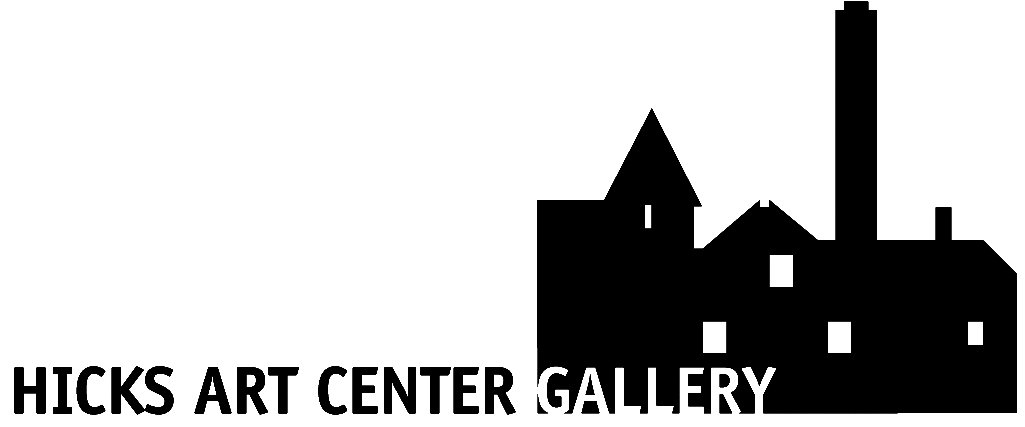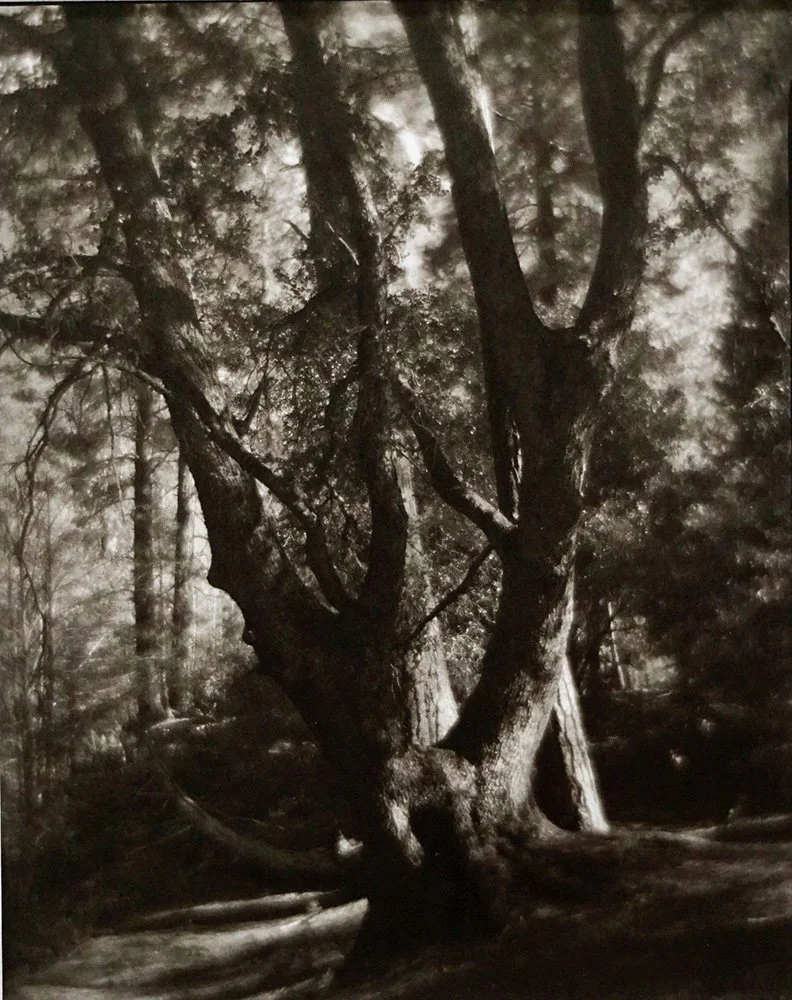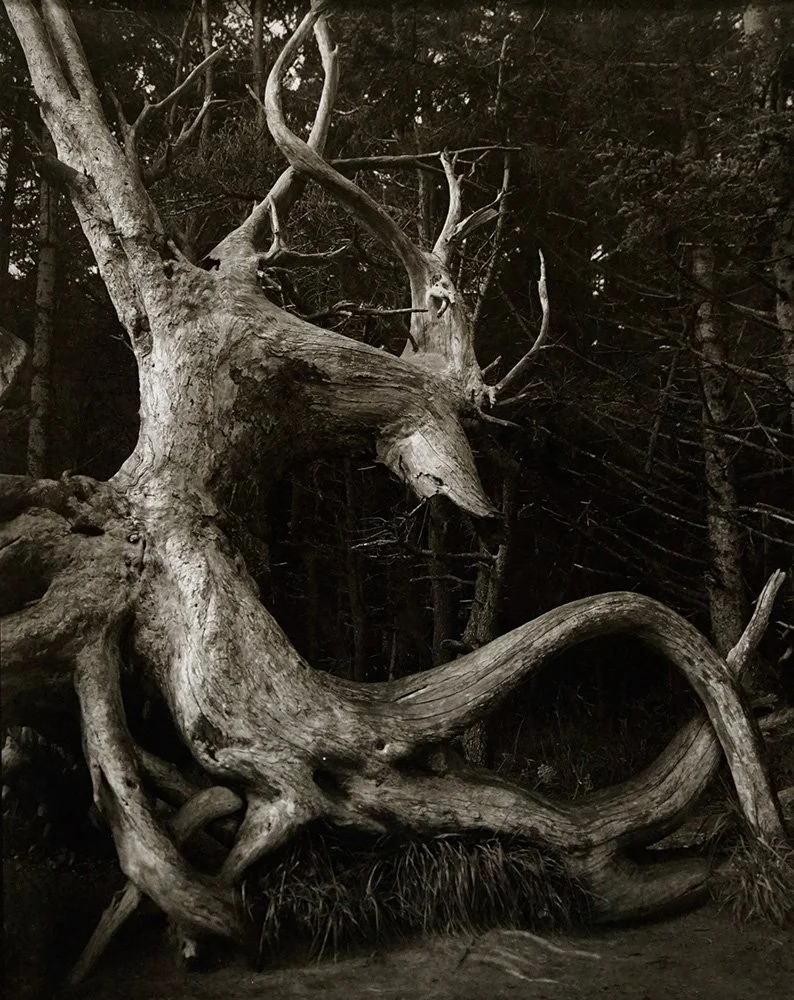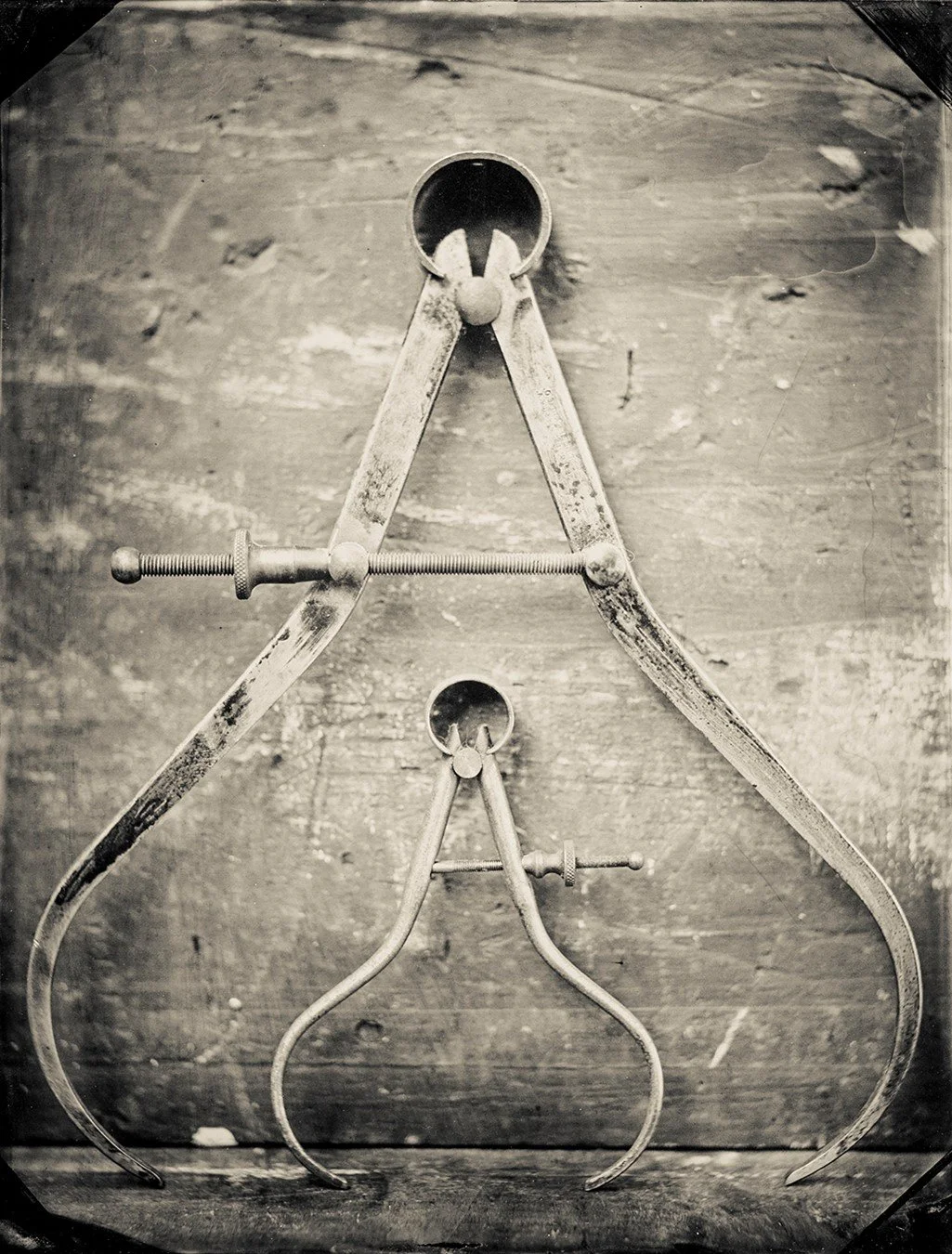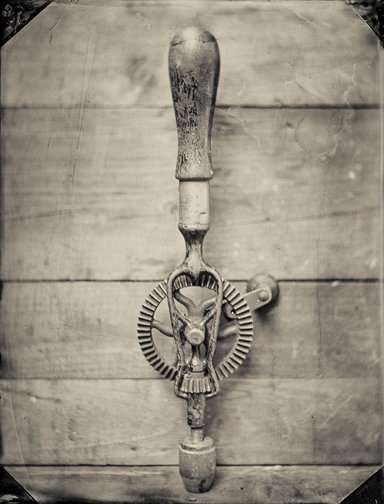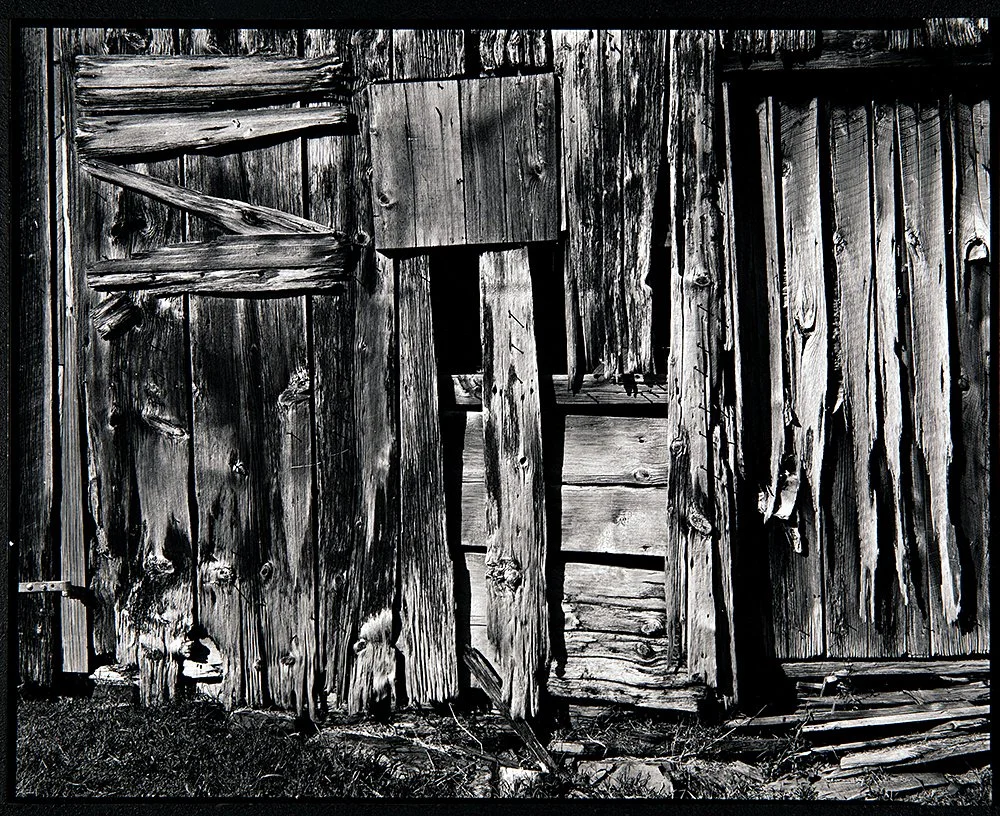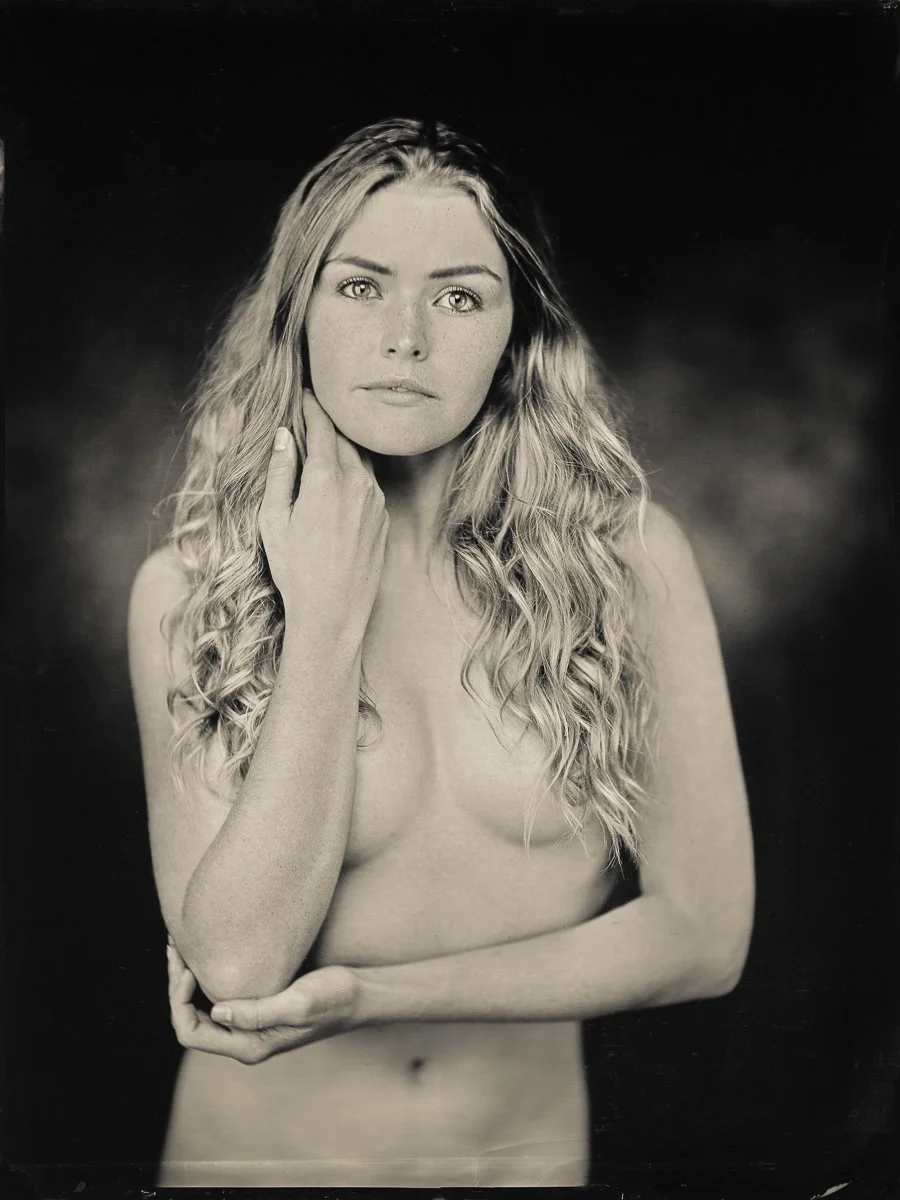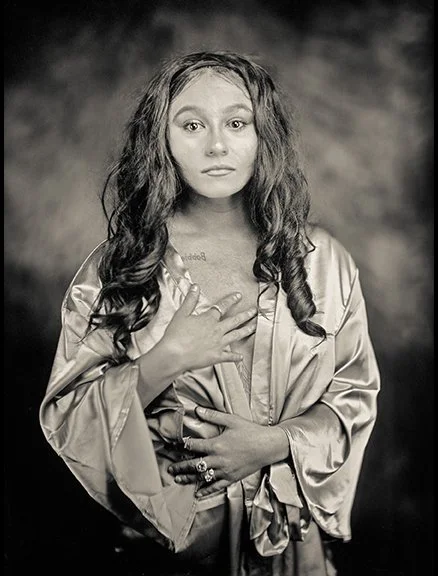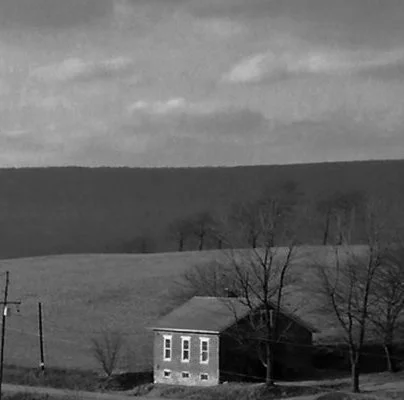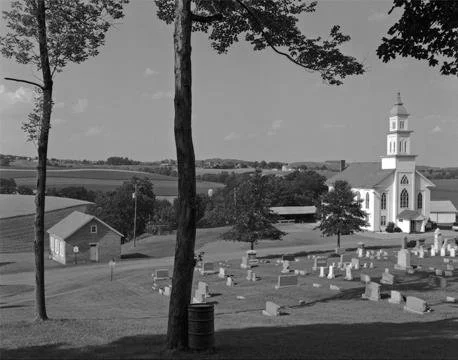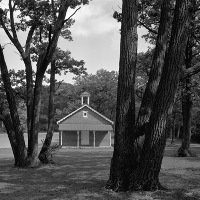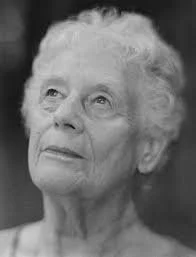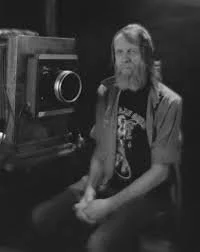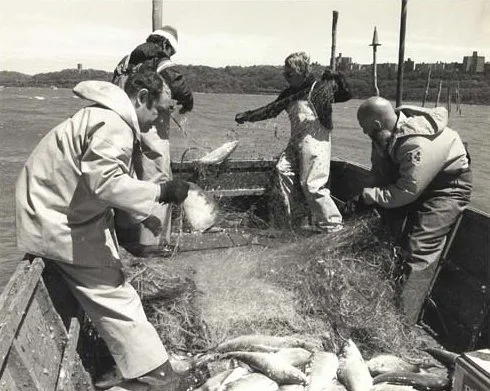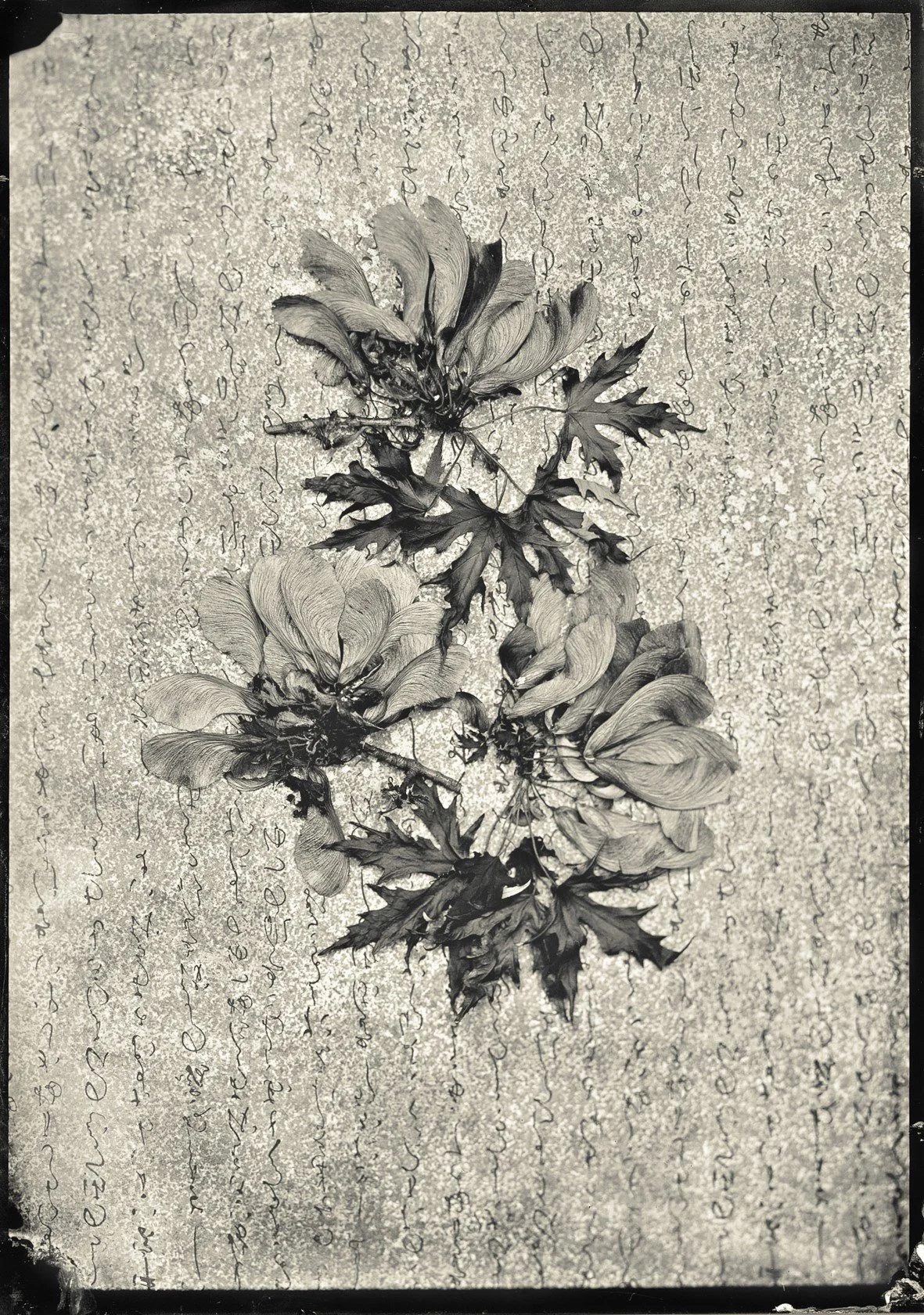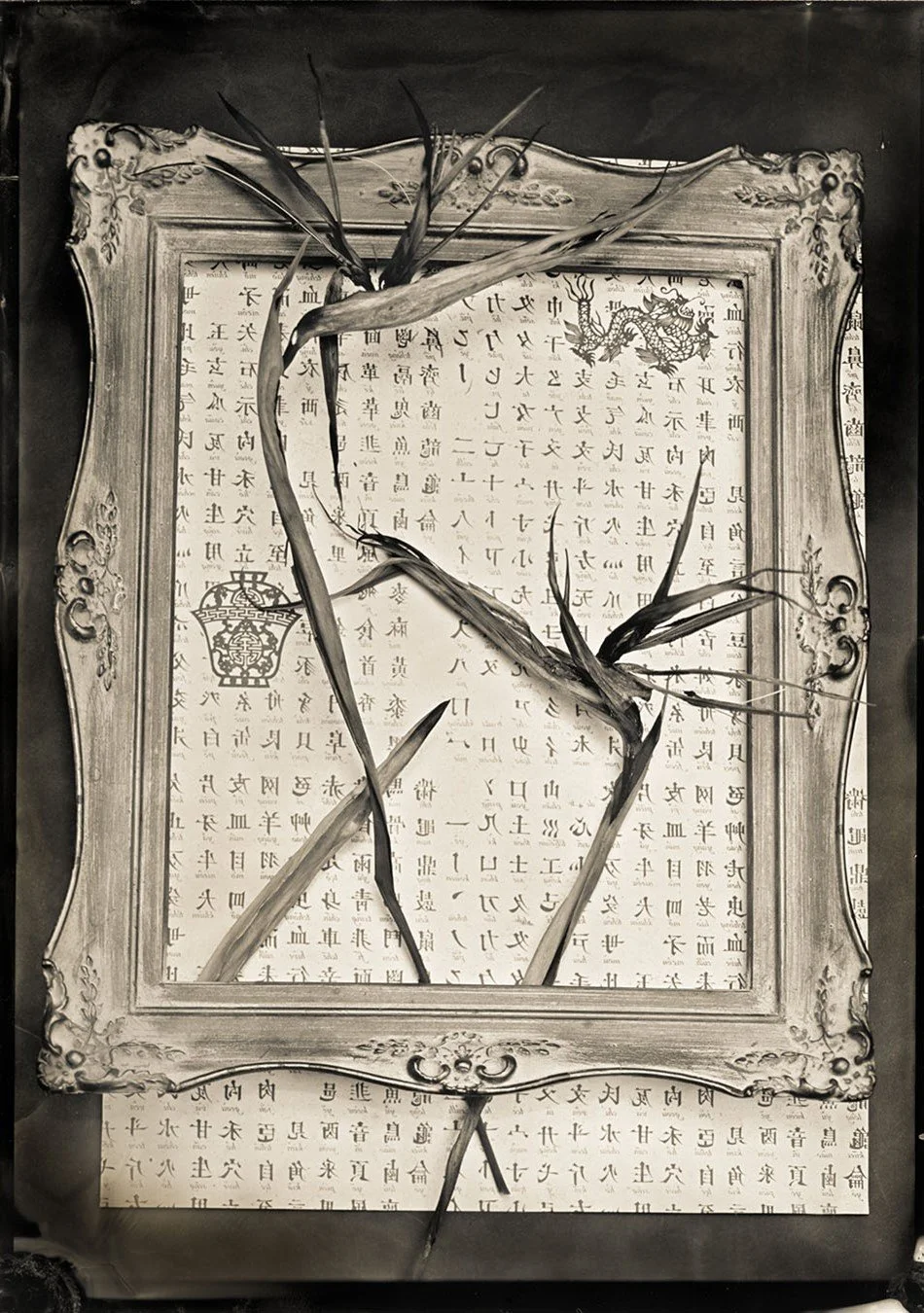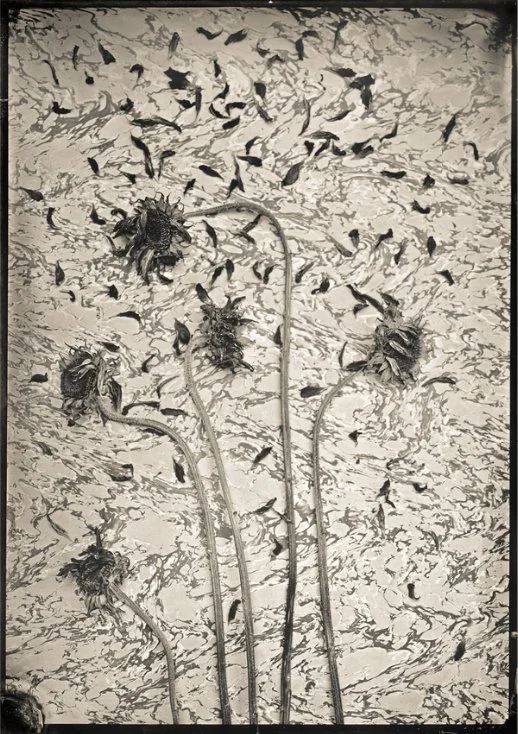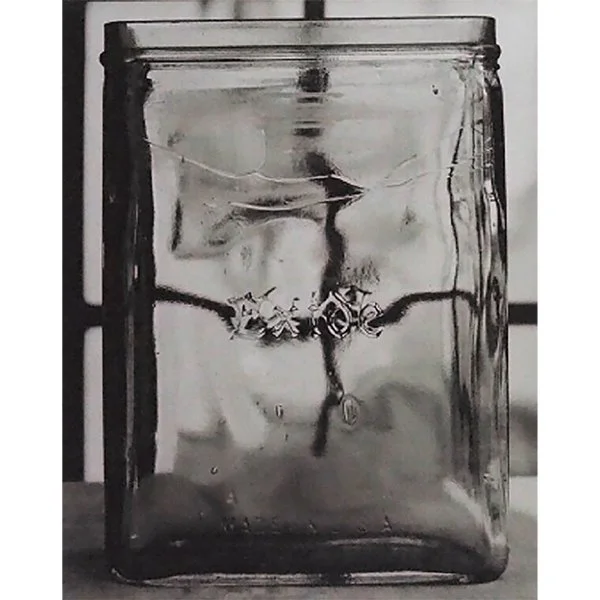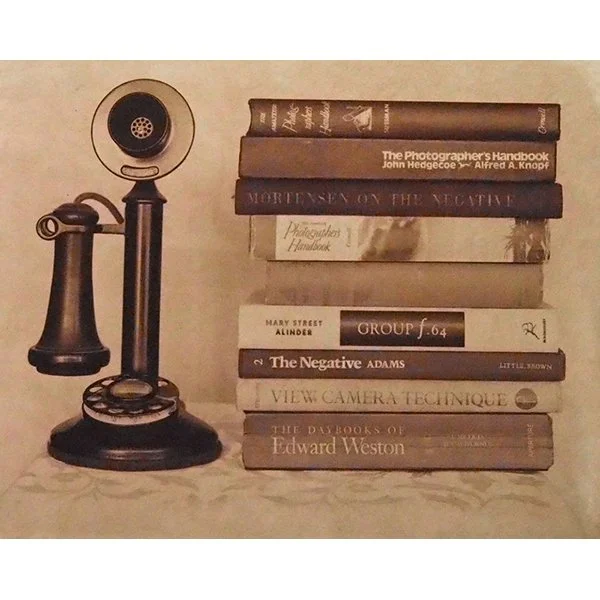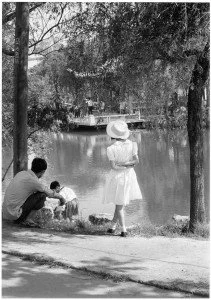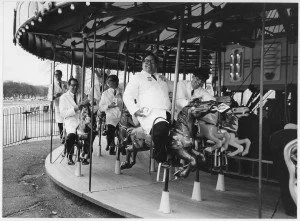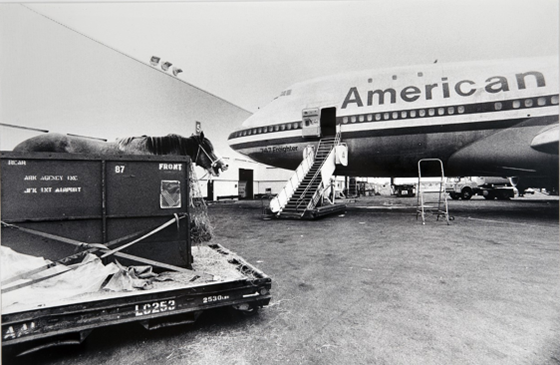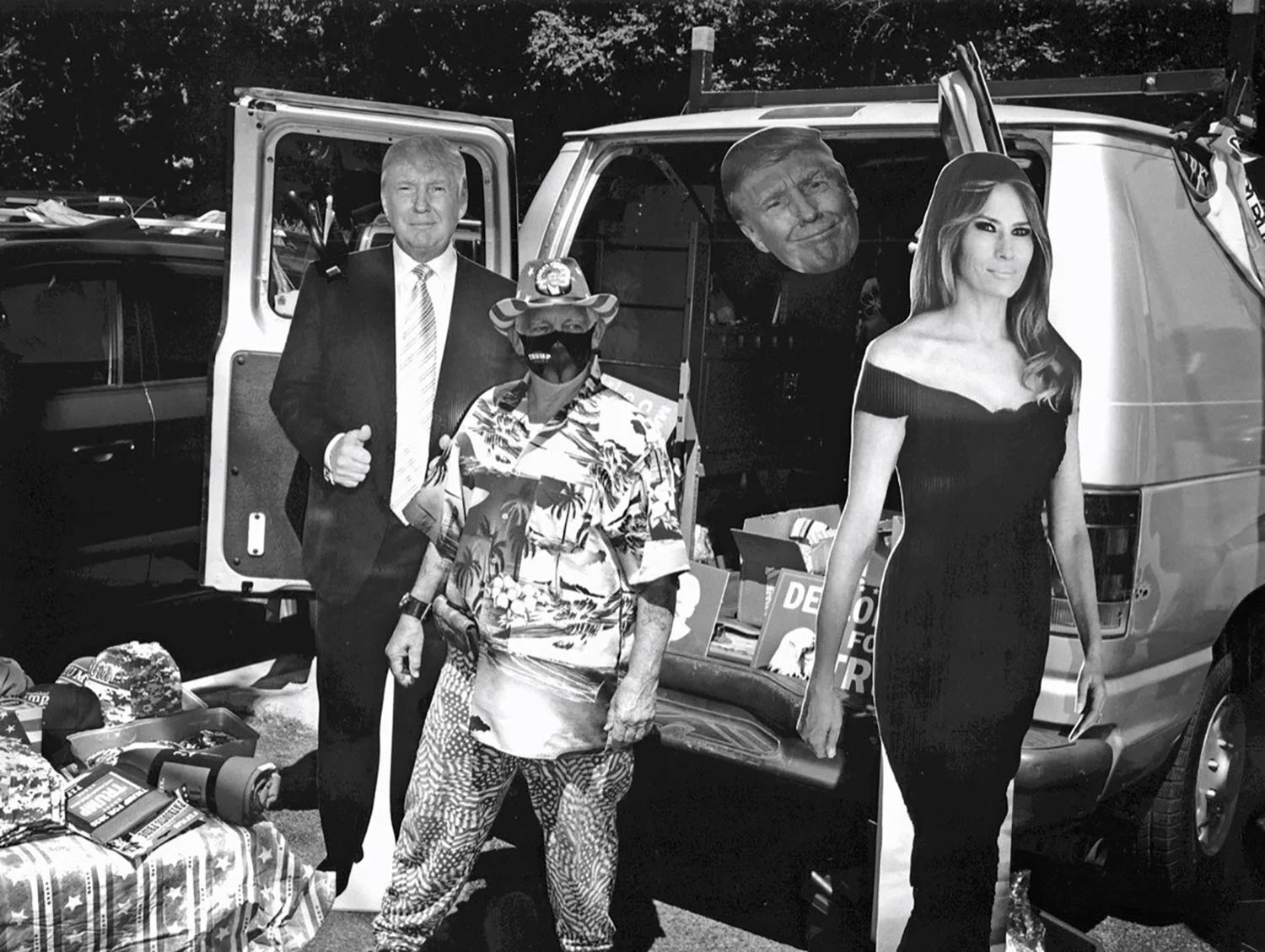Handmade Photographs: The Monalog Collective
January 19 - March 11, 2022
Eye of the Oak: 16 x 20 Carbon Transfer Print
In a Dream: 16 x 20 Carbon Transfer Contact Print
Twisted Elk, Shore Acres: 16 x 20 Carbon Transfer Print
Jim Fitzgerald
“My love affair with trees and the natural world began at a young age. Family trips to Yosemite, Sequoia and the Oregon Coast helped set me on an artistic path which I follow to this day.
As an artist living on the west coast, I am particularly attracted to the beauty of the region’s intimate natural environments. My hand built large and ultra large format cameras are ideal for capturing subtle details of light, surface and space. Every print is hand-made and one-of-a-kind, using a carbon transfer process perfected in 1864. The process allows for an interpretation of the image on film not possible by digital means. The carbon process allows me to achieve relief prints of exceptional depth, tone and archival permanence.
I display prints without glass because I feel that my work is alive and needs to breathe. Furthermore, the archival qualities of my printing process means that nothing in the environment will affect the longevity of the print. Displaying the prints without glass allows the viewer to walk into my work and become one with the image, to explore, imagine, and feel the moment in time through the subtle characteristics of a finely crafted carbon print.”
Open Ended Wrenches: 6.5 x 8.5 Tintype
Calipers: 6.5 x 8.5 Tintype
Hand Drill: 6.5 x 8.5 Tintype
Beverly Conway
“Tools are as old as humankind, perhaps older. They were crafted and used for survival as well as creating art. Although the design and materials have changed, tools remain an extension of our hands and creativity.
Some of my earliest memories are seeing tools in my father’s workshop. They were in constant use building and repairing. Some have been used over four generations — his grandfather to his father to him and now me. They are one of my connections to an earlier time.
My tintype images are one of a kind, each made by hand using collodion, an historic photographic process dating to the mid nineteenth century.”
Factory Work #9: 8 x 10 Palladium Print
Factory Work #4: 8 x 10 Palladium Print
Factory Work #1: 8 x 10 Palladium Print
Martin Frank
“Seeing the world around me through the ground glass of a view camera for the last 20 or so years, I was inspired to attempt to use vintage historic processes when photographing the female figure after I saw Edward Steichen's image, “Little Round Mirror", at a museum. The tonal range and tactile quality achieved especially through palladium have aided me in this project to depict the drama seen when the female figure-with its delicacy-is posed, as it is here, in a harshly lit, abandoned industrial setting.”
Barn, Poultney, VT, 2018: 8 x 10 Silver Gelatin Contact Print
JetStar Roller Coaster, Seaside Heights, NJ, 2013: 8 x 10 Silver Gelatin Contact Print
Thomas, Gettysburg, PA, 2021: 8 x 10 Silver Gelatin Print
Mel Evans
“When I was 7 or 8 years old, my grandfather said I could “play” with his Kodak Brownie Hawkeye camera. I immediately went up and down our Sparrows Point Street lifting the hood on all our neighbor’s cars and photographing the engine. The hood on a 1959 Dodge was quite the lift for such a young boy! But I knew what I wanted, and the obstacle of that Dodge hood wasn’t going to stop me.
In my 43 years as a professional photojournalist, I often had to overcome obstacles much more formidable than that heavy Dodge hood. I didn’t let my fear of heights stop me from climbing to the top of George Washington’s head to make photographs from Mount Rushmore, nor stop me from standing on top of a forest ranger tower to photograph a fire-watch using binoculars in the window below. The word “NO” was an obstacle that had to be carefully moved out of the way almost a daily.
Now, working mostly in Black & White film, I no longer face the expectations of editors and publications and their deadlines. In photojournalism it was often easy to ‘score’ your work against others, because at nearly any given moment, everyone worked in the same medium, often at the same event. With this sort of large, but contained group of peers and publications, quality and creativity rose to the top. But large format B&W is different. It is often solitary work and the en masse, daily comparisons don’t exist. So, now, I’m the one that I work to satisfy. As I work more with B&W and these huge cameras, I am critical of my own results. I am thankful to the serious photographers, both in the past and contemporary, who left a pathway to follow. It is often a path not just of their mechanicals and processes, but of their creative vision of photography. Many have left a high bar. Another wonderful obstacle.”
Katarina: 8.5 x 6.5 Wet-Plate Collodion Tintype
Xuxan: 14 x 17 Wet-Plate Tintype
Magdalena: 14 x 17 Wet-Plate Tintype
Gary Samson
I have been fascinated with making portraits, especially of women, for over forty years. The work presented in this exhibition is an extension of a ten-year project, “Unburdened Beauty: Nude Portraits of Women in the 21st Century” that resulted in a one person show at the Vermont Center for Photography in 2016. To make these portraits, I utilize view cameras in a range of sizes from 4’x5” to 11”x14” using black and white film or the wet-plate process. The images I make are divided between the studio where I have complete control over the lighting, and location work where I can use the subject’s natural environment to help interpret aspects of the subject’s personality.
Important influences on my work include Julia Margaret Cameron, Alfred Stieglitz, Paul Strand and Lotte Jacobi. Lotte Jacobi once said, “Let the subject rule the photograph.” This is a philosophy that I have tried to follow in my own work, allowing the person I am photographing the freedom to shape the image with very little or no direction on my part. I am especially attracted to the 19th century wet-plate process because it allows me to share the tintypes or ambrotypes with the subject as the session progresses, resulting in a truly collaborative process that sometimes takes several hours.
Washington School, Lehigh County, PA: 25 x 32 Gelatin Print
Weisenberg School, Lehigh County PA: 25 x 32 Gelatin Print
Moslem School, Berks County, PA: 25 x 32 Gelatin Print
David W Haas
“In 1986 I returned to the Lehigh Valley from Massachusetts. After earning a BFA in photography from MassArt in 1980 and exploring the natural landscape of New England with my camera for an additional six years, Cape Cod, the Berkshires, Hudson River to Acadia, I felt it was time to head home.
I settled into the town of Kempton, Northeastern Berks County, close by Hawk Mountain Sanctuary, the land of my ancestors. The Schoolhouse Project was inevitable and reflects a desire to blend cultural history within the natural landscape. Many of the brick buildings remain, their iconic structure dedicated to education before consolidation. Their uniformity of design provides a common subjective anchor within a wonderful variety of settings that our region is noted for.
The Schoolhouse Project was instrumental in obtaining an MFA in Photography from the University of Delaware, which led to twenty-six years as a part time lecturer at Muhlenberg College, Allentown, PA. At the same time, it opened a door to the HABS/HAER division of the National Park Service, which I serve till this day.
Sometime around 1900, along with many other students, my grandfather carved his initials on a brick next to the front door of the Weisenberg School. I have a negative of that detail.”
Janet: 8 x 10 Platinum/Palladium Contact Print
Jenksy: 8 x 10 Platinum/Palladium Contact Print
Gordy: 8 x 10 Platinum/Palladium Contact Print
James A Kipfer
“I am predominately a large format photographic artist who prefers to work within the methodical and contemplative confines of the view camera. My images are made with gelatin silver-halide based film and then, depending on the type of emotion I want to convey to the audience, printed on a variety of mediums. I develop and print all of my images by hand one at a time in my Lab.
My main printing mediums are commercially available gelatin silver-based paper, hand coated platinum/palladium paper and hand coated albumen silver paper. I prefer to produce contact prints in lieu of enlargements due to the sensibility and character they exhibit, which is quite unique in the modern world of ink jet prints. However, when I deem that the final expression demands such procedures, I do make enlargements on gelatin silver paper. Each print is washed, toned and mounted by archival methods.”
Two-Man Shad Boat, Near Tappan Zee Bridge: 8 x 10 Silver Gelatin Print
Leaving the Dock, Nyack, NY: 8 x 10 Silver Gelatin Print
Four-Man Shad Boat, Near George Washington Bridge: 8 x 10 Silver Gelatin Print
Paul Margolis
“I’m a photographer who documents little-known aspects of life that are liable to disappear without a trace if I don’t record them. I work with traditional mechanical cameras, 35mm and 120 formats, using black and white film. I process and print the film myself in a classic darkroom setting to achieve the timeless quality and archival permanence that the medium provides.
While my “beat” remains mostly New York City, I have worked on many projects across the United States and around the world. In the mid to late 1980s I had an opportunity to photograph commercial fishermen who caught shad in the Hudson River for a living. The fish run north to spawn in April and May. Commercial fishing for shad is no longer permitted on the Hudson. My photographs are a documentation of that by-gone era.”
Maple Leaf Study: 5 x 7 Wet Plate Collodion Tintype
Birds of Paradise: 5 x 7 Wet Plate Collodion Tintype
Sunflower Study: 5 x 7 Wet Plate Collodion Tintype
Claudia Rippee
“I came to the wet plate process via experimenting and creating with the pinhole camera. In both formats the same ethereal feel is present but with the wet plate process it goes farther. The effects are more dynamic, the images more expressive and the immediacy of result and the longevity of the plates capture my focus.
More like a painting than a photo the wet plate collodion images I have selected have a “not of this time” feel. The process allows me to experience both artistic expression and virtual time travel as I make these images utilizing a process that remains unchanged since Frederick Archer invented the form in 1851. Even though the flowers have passed their life of beauty this process transforms them back to vibrancy. They become part of a new whole that has the life qualities of movement and depth as in a musical score. Through interaction with the chosen backdrops each different botanical specimen takes it part as if in a symphony that draws the viewer deeper into the photograph.”
Alone: 8 x 10 Silver Gelatin Contact Print
Exide: 8 x 10 Silver Gelatin Contact Print
Study: 8 x 10 Albumen Contact Print
Drew Wagner
“I photograph things that I see as well as things that can only be visualized in my mind. Sometimes the subject is an actual place or object. Other times it is made up of the lines, shapes, tones, and/or textures that comprise the place or object.
I find that the use of black and white analog darkroom processes satisfies my creative needs by giving me the tools to represent and interpret, both ordinary and extraordinary, subject matter in the manner that I visualized them.
I work with both a medium format camera and an 8x10 camera. Each is mounted on a tripod allowing for a deliberate and thought-provoking approach. They free both my hands and mind to carefully examine and explore the ground glass imagery that enables the creative process to unfold without distractions.”
Cow Girl, Middleton Grange: 8 x 10 Silver Gelatin Print
A Day at the Lake: 8 x 10 Silver Gelatin Print
Carousel: 8 x 10 Silver Gelatin Print
Michael Marks
“My objective is to create a home for those who love black and white film photography and the black and white silver gelatin prints made from film – for those already using film cameras and working in darkrooms, but more importantly, for those that have yet to give these wonderful mediums a try.
My purpose is not to bash digital photography or processes, or for that matter color, be it digital or film based. By all means enjoy them. Rather, it is to create a friendly ecosystem and foster a home for a community of those fascinated by something unique and wonderful that just won’t go away — black and white analog photography!
My hope is that I can share stories and my experiences, and by doing so to encourage those that are already using film and are making silver prints to continue doing both. I also want to encourage those that are shooting film but have yet to step into the darkroom to try it. Finally, I hope to demystify and remove the fear for those that have never tried or thought about trying black and white analog photography and printing. Simple and fun! Sounds like a good idea.”
When Horses Fly: 13 x 17 Silver Gelatin Print
Trump Merchandise: 13 x 17 Silver Gelatin Print
Thomas and Mannequin: 13 x 17 Silver Gelatin Print
Ed Eckstein
Photographic truth is very malleable, I find that both the image maker and viewer are in possession of a medium that can significantly alter the way we view the world and process the information it contains. All of this leads me to my interest in the capture of the non-fiction image, distilled from visual encounters with humanity and place. The camera is my tool, selected to understand life and communicating the result to others.
In my approach to work about the human condition I shy away from the aspect of photographic coverage and tend to be involved in photographic dis-coverage. It seems to me the paradox of life as well in photography is to go out and seek things which you never expected.
I like to think of my work as imagery that prevents truth decay and represents honest non-manipulated photographs.
